|
You are here: 4Campaigns & Battles4Index4The 1st Schleswig War |
|||||||||||||||||||||||||||||||||||||||||||||||||||||||||||||||||
|
1st Schleswig war (1848 – 50):The War where the Navy again became the Leading Light - and the Ray of Comfort - for DenmarkThe Danish fleet managed to keep a total blockade of the north German coastal harbors. Apart from the Eckernförde catastrophic affair the navy went from victory to victory. It also became the war with Danish paddle steamers for the first time playing a decisive role. Not just as warships, but also ferrying army troops between the different battle sites. Thus giving the army a high degree of mobility. By Johnny E. Balsved/translated by J. N. Andersen The year 1848 arrived quietly and peacefully without any indication of a looming war. By January 20, the old King Christian VIIIth died and was replaced by King Frederik VIIth. The new King had just given his permission to the introduction of the peoples parliament and a new Constitution for the Danish Kingdom. This did not include the Duchies Schleswig, Holstein and Lauenburg, all south of the border of the Kingdom. The duchies Holstein and Lauenburg were members of the German confederation, and the Danish King was thereby also member of the German confederation, while Schleswig was outside both the Kingdom and the German confederation.
The Navy prepares At Holmen (the navy dockyard) it was 34 years since an order to rearm had been issued. At that time unfortunately it was only to later hand it over to the English. Late evening March 25, the news arrived in Copenhagen: The army garrisons in Kiel and Rendsburg had joined the insurgents. As soon as next afternoon the first Danish warships left from Copenhagen with destination around the peninsular Als (East Coast of southern Jutland).
Flensburg falling The next day March 28. The paddle steamer GEISER entered Flensburg fjord for a reconnaissance and simultaneously try to deliver the proclamation from the Danish King to the Schleswigians. The town of Flensburg although was the same day taken into the possession of the insurgents, under the command of General Krohn. When GEISER approached it was met by heavy gunfire from the insurgents. They were in charge of some of the houses on the waterfront. Wisely the Danish ship choose not to answer the gunfire against the open city. GEISER left and steamed slowly out of the inlet. A withdrawal that was immediately taken as a great victory by the insurgents. The navy in battle for the first time Encouraged by the success at Flensburg, the General of the insurgents chooses to continue towards Aabenraa, as early as March 30. The advance towards Aabenraa went ahead smoothly, until the rebel troops reached the southern part of Aabenraa fjord. Right in the middle of the inlet they saw the Danish Naval Ensign flying on top of the Brig ST. THOMAS. Under the command of Lieutenant Commander M. Suenson they had taken station in the Aabenraa fjord. The Brig immediately opened fire towards the insurgents on the coastal road. Soon the advancing insurgents were in a muddle. Shortly after ST. THOMAS fired, the first shot of the war, the insurgents were in full retreat across the fields - away from the coastline. The insurgents then entered Aabenraa from the west, outside the reach of the Danish naval guns. The city after all was occupied. The Navy presence though turned out to be more than the insurgents had expected, and all traffic along the coast was in danger. The call for blood The next morning the anti-Danish population of Aabenraa woke up to the news of the Danish blockade had been escalated. During the night the paddle steamer HEKLA, with Commander Steen Bille had arrived in the Fjord. Both vessels were now on stations with guns pointing at Aabenraa City. In the harbor of Aabenraa the steamer CHRISTIAN DER ACHTE lay alongside. Commander Bille, as Chief-in-Command, gave ST. THOMAS order to take the steamer. Lieutenant Commander M. Suenson, chief of ST. THOMAS, left with three boats and crew to lead the charge. As they arrived into the harbor they were met by a crowd of curious onlookers, civil and soldier alike. An officer wearing the uniform of a Danish ranger, with white armband around the arm, called out loud as the boats drew close; "it will take blood". With the shout "let it take", Magnus Suenson and his crew jumped ashore. Without as much as a fight, and in no time, they were in command of the steamer. Under the cover of canons, at the two warships, they brought the steamer safely into open water. The Troopships
Picture showing the Horse Guarded loaded in Korsor 1848. The first Danish Secretary of the Navy
This amounted to readiness and capability to meet the demand for transportation of troops between the different theatres of war. The main task of The Navy To support the army was mainly to pro-actively support the flanks as the army went south. To solve this task a Squadron was formed by the corvettes GALATHEA and NAJADEN, the brigs ST. THOMAS and MERCURIUS, the paddle steamers GEISER and HEKLA as well as 10 gunboats and 6 skerry gunboats. As Chief-in-Command of the naval force Commander s.g. F. Paludan raised his pennant on the GEISER. His second in command, Commander Steen Bille raised his on the HEKLA. Troop carriers under the command of Commander P. W. Tegner managed quite a big selection of private steamers and sailing ships. At first at Korsor, but later on the island of Funen and in the fjord of Flensburg. With good fortune the fleet managed to support the army on its advance towards Schleswig. Especially Commander Steen Bille with HEKLA was highly visible. Another fight in Flensburg fjord As soon as April 07, the navy went into battle again. East of Holnis at Bogholm, close to the entrance of the fjord, the insurgents were erecting field artillery on the very seashore, the insurgents were about in great numbers. The corvette NAJADEN, the paddle steamer HEKLA and 2 gunboats all having stations at the entrance, went into battle stations. HEKLA and 2 cannon boats, all close to the shore, took the fire from the shore. Commander Steen Bille, with the HEKLA guns, managed to silence the shore artillery. The insurgents again had to flee inland and the area apparently was cleared of insurgents. On April 09, 1848 when the army won the first laurels in the battle at Bov nearly the entire naval force were gathered in Flensburg fjord. GEISER, HEKLA, GALATHEA and NAJADEN subsequently transferred troops to Eckernförde. The loss of Fehmarn Following the transfer of troops to Eckernförde the NAJADEN was ordered to Fehmarn to secure the island from the insurgents. Lieutenant Commander Dirckinck-Holmfeld, whom with great ability had organised the defenses of Als, was now asked to repeat this at Fehmarn. The NAJADEN arrived with the cutter LØVENØRN, April 15 in the morning; offshore Burgtiefe on the east coast of the island – but too late. As they arrived they saw the rebel flags flying at several locations along the shore. All the same Dirckinck-Holmfeld tried to go ashore to investigate the mood on the rebelliously island. As soon as the Lieutenant Commander and 2 men came ashore with the rowing boat, the insurgents took them prisoners. Some local people tried to defend them; one of them died from an enemy gunshot. The NAJADEN then left Fehmarn, Commander Krenchel now appointed the new commander. The German Confederation enters the war The war developments now picked up speed. The German confederation more and more appeared to take Site with the insurgents. April 18, 1848, the German confederation declared war against Denmark. The German army corps, under the command of general Wrangel, mowed up through Holstein. This army corps mostly consisted of Prussians and Hanoverians. 5 days later at Schleswig, Easter Day April 23 it came to the first battle, between the superior German forces and the Danish army. Following an honorable Danish effort the outnumbered army were forced to retreat. At first to Flensburg then to Als, Funen and Northern Jutland. HEKLA, with the assistance of some cannon boats, managed to relieve an army detachment caught at Eckernförde. Meanwhile most of the naval force assisting in the Flensburg fjord. The blockage implemented With general Wrangel mowing north in Jutland the naval force tasks were reduced to keep the water safeguarded. The enemy was to be denied the crossing of any stretch of water. By the end of April most of the navy vessels were in a state of readiness to start the next operation: The blockage of all German harbors from Kiel in the West to Pillau in the East. April 29, the Danish naval force blocked all German Baltic Sea harbors. The force included the frigates HAVFRUEN and THETIS, the corvette FLORA and a number of smaller vessels. The midget state Denmark attracted the attention of the European powers, by their heroic effort and not the least by the damage the blockage caused to the Baltic trade. Negotiations commence A number of Swedish and Norwegian volunteers were ready to join Denmark under the Danish flag, this army of 15.000 volunteers now gathered in Southern Sweden. With the Swedish King as mediator and with England as guarantor, delegates met in Prussia and Denmark to negotiate a settlement. In the middle of these negotiations general Wrangel suddenly (Mai 25) mowed his headquarter from Northern Jutland to Flensburg. In Malmoe, Sweden, they reached a draft resolution for a cease-fire. This was then forwarded to General Wrangel and the Danish General Hedemann. The sub negotiations between them were discontinued as the Germans were said to be double-dealing. Danish attack and victory Meanwhile the Danish generals based on Als, decided to attack the flanks of the enemy. May 26-27, the navy transferred army troops from the island of Funen to Als. For some days the Danish army were fighting some of its noblest engagements, May 28 at Nyboel and June 05 at Dybboel. The navy contributed and not the least the NAJADEN – but – the victories all belongs to the army. Early June a division, of 3,500 volunteers from the "Swedish" army, were transferred, from Gothenburg and Malmoe, to Funen. Under the command of general Loevenhjaelm they were to assist the Danish troops. It was also decided to extend the navy blockage to include the German harbors in the North Sea. Most important were the German estuaries. The frigates BELLONA, GEFION and THETIS made up a new naval force, the newly outfitted frigates were under the command of Commander Steen Bille. The frigate HAVFRUEN (The Mermaid), doing duty in the Baltic Sea joined the new naval force. The just completed frigate FREIA replacing HAVFRUEN in the Baltic. The last shot in the 1. war The near 30-year-old corvette NAJADEN was not just to fire the first shot in the war. Now it was at station off Flensburg under the command of Commander Krenchel with 2 assisting cannon-rowing boats. It was from this position, that the last shot in this first part of the war was fired. Their task was twofold. In the first place to keep on eye on the inroads to Flensburg, secondly forestalling the enemy occupying the peninsular Holnis. The crew onboard the three vessels were convinced that the cease-fire would be in place within the next few days. The last shot surely must have been fired. A cease-fire, that would also bring to an end their boring duties of the blockage. NAJADEN dupes the artillery of the enemy Late evening August 16, Commander Krenchel receives information from a local fisherman. The fisherman had rowed his boat out to the station of the NAJADEN. On board the ship he told the officer about an enemy army artillery station next to his house on the shore. The distance to the corvette had been adjusted, and cannon balls were made red-hot in the oven. It was evident they were planning to set the corvette on fire by the first light in the morning. Commander Krenchel immediately went into action. Under cover of the darkness the NAJADEN silently warped further away from the shore. With the broadside towards the shore and the crew at the cannons the NAJADEN was prepared. By first daybreak August 17, the crew on the NAJADEN took great fun, by observing the enemy cannon balls sink into the location they had shifted from during the night. In the early morning light the enemy realized the mistake and the cannon sights were adjusted. For more than an hour both sides had casualties. The corvette took some hits as well as some crewmembers were fatally wounded. The two gunboats, at anchor by Egernsund, came to assistance and attacked the enemy flank. The shore battery was now on fire from two sides. The shore battery was soon forced to flee. The last shot had been fired. Seven months of cease-fire August 25, 1848 in Malmoe (Sweden) Prussia and Denmark finally established a 7 months cease-fire. The truce offered Prussia the right to keep 2,000 men in Schleswig. Denmark the same conditions for the peninsular Als. All prisoners of war to be released as well as seized vessels and their cargoes. But the truce was not to be extended. As soon as February 1849, the Danish government decided to give notice to terminate the cease-fire. This serious step was mainly due to the German atrocities in south Jutland. Denmark prepared for a new war During the wintertime and the early spring of 1849, Denmark had time to make preparations for the possible reopening of the war. On Als, Funen and Jutland the army been strengthened and fortifications improved. The navy had been equipped, not just for supporting the army but also to implement navy blockage of German harbors in the Baltic and North Sea. Several members of the Government were replaced. The Secretary of the Navy, Commander s.g. C.C. Zahrtmann was one of the few who retained his position.
Frigates are manned and made ready for
war at the Naval Dockyard The navy had now reached a considerable strength with the foremost and new ship-of-the-line CHRISTIAN VIII. It had been equipped with a total of 84 guns, and placed under Commander s.g. F. Paludan. In addition the frigates GEFION, THETIS, BELLONA, ROTA, HAVFRUEN, FREIA and NYMPHEN, as well as the corvettes NAJADEN, GALATHEA and FLORA were equipped. Further enlisted were the brigs ST. THOMAS, ST. CROIX, MERCURIUS and ØRNEN (The Eagle), the paddle steamers HEKLA, GEISER and SKIRNER and a collection of smaller vessels, steamers, gun shallops and gunboats boat made up the entire force of the Danish navy. The War returns The 7 months cease-fire expired March 26, 1849, while some negotiations still going on in London the truce was extended for another 8 days. But that was just a short postponement. On the morning of April 3, the Danish army crossed the strait of Als and mowed towards Sundeved. At the same time general Rye approached Kolding. The navy played its part. Commander Dirckinck-Holmfeld with NAJADEN and some gunboats arrived at Aabenraa, expelled the enemy and occupied the city. In Flensburg fjord the frigate HAVFRUEN, with Commander Petersen, attacked enemy troops at Egernsund. The very same day the Danish Secretary of Defense, who resided in Sonderborg, gave order to stop any further advance. He was afraid the army might get too far. By that evening, a small steamer left, with the required orders for general Rye in Haderslev. A former planned navy operation at Eckernförde ought now to have been cancelled, but it never happened. The only and most devastating navy loss during the Schleswiger wars was about to happen. The catastrophe at Eckernförde As early as April 2, at a meeting in the headquarter in Sonderborg, it had been decided to stage a navy operation against Eckernförde, to support the advancing Danish army. Present at this meeting were Superior General, General major v. Krogh and Captain H. C. Garde who was the Chief-in-Command for the Squadron on the East Coast of the Duchies. On the evening of April 3, the final order was inked for the expedition. Despite the Secretary of Defense had stopped the advance. The next morning the order was given to Commander s.g. Paludan who, as Commander of the ship-of-the-line CHRISTIAN VIII, would be in charge of the operation. The main purpose of the operation was to destroy the German fortifications by the entrance to Eckernförde and such ease the army operations against the town - the very same operations that had been halted the day before. In addition to CHRISTIAN VIII, the frigate GEFION the paddle steamers HEKLA and GEISER were made available for the expedition. Furthermore they were reinforced by a detachment of soldiers from Sonderborg. During the day the crew on CHRISTIAN VIII had to learn gunnery practice etc. The vessel and crew had never been in any battle before. Same afternoon the flotilla arrived on the Site. Maundy Thursday once more a fateful day Next morning at dawn, Maundy Thursday April 5 1849, all Danish man-of-war vessels were readied for battle stations. The strategy was reviewed.
The Frigate
GEFION and the
ship-of-the-line
CHRISTIAN VIII What originally was conceived as a simple operation, would prove catastrophic for the Danish vessels. This was in part due to the wind conditions and part due to insufficient intelligence. In addition to the known established fortifications the Germans had considerable more strength and artillery in the area. This was soon brought to the sites against the Danish flotilla. The situation turned terrible against the Danes, their vessels and Commander Paludan. Late in the battle he had to ask for a truce. He appeared to be trying to bring the vessels out of the fjord against the increasing easterly wind. The Germans delayed the truce negotiations and used the time to reinforce their positions as well as bringing more troops into the theatre. No earlier than late afternoon the German reply was brought forward. It turned out to be a clear request for Danish capitulation. A humiliating defeat The battle resumed by 17:00 in the afternoon, by this time the frigate GEFION was a spent force. Shortly after the frigate had to strike the flag while CHRISTIAN VIII made a last attempt to escape. With the sails in tatters and onboard heavy fire CHRISTIAN VIII soon had to strike the flag too. The crew at last had to give up the fight against the many fires, and orders were given to abandon the vessel. A crew, of about 100 men, were still onboard the vessel when finally the fire reached the gunpowder and CHRISTIAN VIII was no longer the pride of the Danish navy. The navy had lost two of the best vessels, more than 200 killed and wounded, and about 900 men taken prisoner. Maundy Thursday then once again turned out to be a fateful day for the Danish navy, and to be remembered with the Battle of Copenhagen - Maundy Thursday April 2, 1801. Total fleet blockage Following the embarrassing defeat at Eckernförde all German harbors in the Baltic and the North Sea were blocked closely by the Danish war ships. The German Sea lanes and coastal trade were stopped. German flag carriers coming off any harbor were seized at all times. This total blockage not only disturbed the German confederation, but many seafaring nations, and England more than most. For the Danes it was important to keep the enemy under pressure, and thereby denied them access to the Danish archipelago. This was the only way to keep the oversized neighbor from getting a foothold in Denmark. The German navy striving In the North Sea Captain Steen Bille performed the difficult blockage with 4 frigates, one corvette and the paddle steamer GEISER. The blockage persisted, even at one stage they had to leave the North Sea Islands as the Danish vessels were too big for chasing the German gunboats in the narrow and shallow water channels. The Germans worked hard to create a fleet of armed steamers capable of breaking the Danish blockage. In Bremerhafen they managed to upgrade 3 vessels. The BARBAROSSA with 9 canons, HAMBURG and LÜBECK each with 16 canons. On June 4, under very calm weather conditions, this small flotilla steamed out of the Weseren River. The German armed steamers were heading straight for the corvette VALKYRIEN because she was on station away from the main body of the Danish vessels. The German steamers formed a line and opened fire from far off. Meanwhile the VALKYRIEN started to work its way towards the island of Heligoland where a couple of Danish frigates were stationed.
GEISER and
VALKYRIEN pursue the
German steamers in the North Sea. After two hours of the thunder of guns the GEISER came to the rescue and the German steamers started to retreat. The frigates THETIS and ROTA meanwhile blocked the retreat to the Weseren and the German ships had to seek refuge on the Elbe River. The blockage in the Baltic Sea In the Baltic the blockage went from Kiel in the west to Danzig and Pilau in the east. The ship-of-the-line SKJOLD and the frigate FREIA were stationed around Kiel, and the corvette GALATHEA and the brig ST. CROIX to the east. In the afternoon of June 27 the Prussian steamer DER ADLER left Danzig and sailed along the coast in the bay of Danzig. As she kept on steaming she got closer to the brig ST. CROIX which was under the command of Lieutenant Commander P. C. Holm. The wind was near nil and the brig could not move at all. The Prussian steamer had the advantage as well as some very heavy guns. About 14:30 DER ADLER opened fire against the brig, the range was about 1 km. The guns made no harm; on the contrary the return fire from ST. CROIX hit DER ADLER. P. C. Holm tried to turn his ships broadside to the enemy. He then made the best use of a slight breeze to bring him up to the GALATHEA, some 20 miles to the east. For the best part of two hours this trading cannon balls went on. The German steamer could not get any closer to the Danish brig their guns could not close the gap. As the vessels drew closer to the corvette GALATHEA, DER ADLER finally gave up and returned to Danzig. Readying for counteroffensive Onshore the Germans were advancing north in Jutland and pursued general Rye. The Schleswigians besieged Fredericia while a 3rd party - the Hanoverians - were stationed by Dybboel. April 13, General Bülow had taken over the command of the Danish army. It was soon decided to make use of the operational freedom given by our command of the sea-lanes. This freedom should be used to make an attack from one of the many flanks and General Bülow chooses Fredericia. The navy transports division, under Commander P. W. Tegner, were busy transferring troops between the islands. Late June, parts of the troops were transferred from Als to Funen. July 4 and 5, the vessels were bringing a major part of General Ryes army away from their pursuer at Helgenes. The troops were transferred to Funen, where the converged at Strib and Middelfart from there they were secretly taken to Fredericia by the navy transport. The lunge from Fredericia July 6, 1849 became a day of remembrance for the Danes. The Schleswig/Holstein forces, occupying Fredericia were totally overwhelmed by the fierce and unexpected attack in the middle of the night. After a severe and bloody fight, outside the fortifications, the rebel army was in total disintegration and the defeat absolute. The navy participated on both flanks. At Skaerbaek, to the right side of the enemy, a paddle steamer and 1 canon boat under the command of Commander Krenchel. In the aftermath they escorted 18 transport vessels with soldiers to Snoghoj for occupation of the site. At Randers Fjord, to the left of the enemy, the navy activities achieved even more importance. 4 Steam ships and 2 gunboats operated under the command of Lieutenant Captain Muxoll. Captain Muxoll succeeded in landing 50 soldiers, whom with he assistance from the gunboats could cut off the rebel army’s retreat. While the advancing Danish army blocked/off any other possible retreats. Thus they succeeded in capturing one complete brigade of enemy soldiers. Cease-fire once again The Danish blockage of the German harbors, had a strong influence especially on the British and Russian trade. The two countries subsequently took initiative to restore the peace. Prior to the Danish victory at Fredericia negotiations had taken place in Berlin. July 10, 1849 it was decided to initiate a new cease-fire. This time for a total of 6 months and 6 weeks. The cease-fire of course required the hostilities came to an end and the navy blockage of the German harbors stopped. The seized vessels were to be returned. A demarcation line was drawn south of Flensburg. The area to the south should be under the control of Prussian troops; neutral Swedish troops should control the North Schleswigians area (today Southern Jutland). During July most of the blockages were lifted, although Kiel and Eckernförde not before August 25, this was mainly due to the Schleswig-Holstein troop insubordination. To ensure the safety of the frigate GEFION an observation squadron was kept at Eckernförde. Short-lived peace In Berlin the peace negotiations were drawn out because of the Prussians. They changed attitude with respect to the Schleswig constitution and administrative separation as well as the official connection with Denmark. Under pressure they finally signed the treaty as late as July 2. 1850. They signed on their own as well as for the German confederation. But this was only a customary peace with each party standing on their right. This implied that Prussia just wanted to wait for a more convenient time and place. Our diplomacy had as such lost the peace that the Navy had forced onto the enemy. The war breaks out again In Holstein the insurgents had used the prolonged truce to collect an army of 30,000 men. This army was in position at Rendsburg and consisted for a great part of German volunteers, under the command of the Prussian general Willisen. The ink was hardly dry before the rebel army crossed the Eider River and advanced north to occupy Southern Jutland. The Danish army, now 40,000 men, was well prepared, and under the command of Major General Krogh they hurried into the duchies from Northern Jutland, as well as from Funen and Als, to meet at Flensburg. As early as July 24 & 25, the two armies met at Isted in a bloody battle. The insurgents lost and the Germans were running for hide on the other side of the Eider river. The Danes army now occupied Dannevirke and the borderline from Eckernförde to Frederiksstad while the Navy protected each flank. The Navy once again goes to sea At the same time as these onshore activities the navy again prepared for more activities. With just the rebel army left the blockage consisted of only Holstein and Southern Jutland water. Hence only a few vessels were prepared. Commander s.g. Steen Bille was made Chief-in-Command stationed and took station on the East Coast. He raised his pennant on the paddle steamer SKIRNER. Under his command he could call the ship-of-the-line SKJOLD, the frigates FREIA and THETIS, the paddle steamers HOLGER DANSKE, HEKLA and EIDEREN, the corvette VALKYRIEN and the bark SAGA. Furthermore 4 gunboats at Fehmern, which was taken into custody July 17th, and some 4 gunboats at Eckernfoerde and finally 8 gunboats at Slien. The battle at Neustadt Schleswig-Holstein, with assistance from friends to the south, had acquired a few steam vessels and gunboats. They wanted to play a role with this material. The Danish squadron commander received message on July 17, about the Schleswig-Holstein steam gunboat VON DER TANN had passed through the Fehmern strait on it way for Neustadt. The paddle steamer HEKLA, under command of Captain Edouard Suenson immediately left for the area. July 20, HEKLA sighted the gunboat just outside Travemünde. The gunboat was up the Trave River before Suenson could get within reach.
VON DER TANN is at fire, while the Danish Paddle steamer HEKLA (to the left) has ceased fire. In Lübeck, being German and hence neutral, they were not very pleased with this unexpected visit. The insurgents vessel subsequently was ordered to leave the harbor. In the early evening darkness VON DER TANN tried to sneak away. HEKLA - on guard - took up the chase. Following a short but hectic close in-shore fight, the insurgents ran their vessel on ground, put it on fire and left. Shortly after the vessel exploded and then burned down to the waterline during the night. The black robber The battle with the Schleswig-Holstein steam gunboat VAN DER TANN was the last time HEKLA and Commander Suenson had the opportunity to make their mark during the wartime. Next month, August 16, HEKLA again in the line of fire – this time in the Kieler bay area. HEKLA, as part of the blockage party in front of Kiel, this time entered into a battle with the Schleswig-Holstein steam-vessel LØWE and four gunboats. One of the gunboats went up in flames; the insurgents subsequently left the battle. HEKLA, with active and alert actions came to be known as "THE BLACK ROBBER". A name was also born by its black-painted wheel-boxes.
The paddle steamer
HEKLA, which the
insurgents nicknamed "The Black Robber". The battle of the North Sea Islands In the North Sea several attempt were made to occupy the North Sea Islands ("Vesterhavsøerne"). Due to the size of the Danish vessels it was difficult to manage in the shallow water area – called "Vadehavet". The insurgents defended the area with their steam-vessel KIEL and 3 gunboats. Mid August 1850, a division of 6 gunboats arrived to reinforce the Danish presence. From about September 17, the waters were rid of enemy vessels. Now the islands could be occupied and the gunboats could commence a blockage of the river Eider from the western end. Finally peace On the East Coast of south Jutland the vessels tried to support the army operations as much as possible. Not the least at Eckernförde September 12 & 13, as well as after the battle at Mysunde. At Eckernförde Captain Bille led the battle and transferred troops. After the battle gunboats entered the Schlei Förde to support the army. The following months the armies confronted each other across the Eider River, while the navy guarded the waters and the coastlines. As the vessels were laid up for winter a company of marines were formed to protect the coast on the flanks of the army. January 1, 1851 the war was over, as the conditions in Germany forced the insurgents to lay down their weapons and the Schleswig-Holstein army was disbanded. The three-year-old war finally came to an end, the peace was re-established and Southern Jutland returned to Denmark.
- Do you miss a major event on this Site,
Are you able to contribute to the unfolding of
the Danish Naval History, You can also use the Naval Web Forum on this web-site.
|
- |
|||||||||||||||||||||||||||||||||||||||||||||||||||||||||||||||
|
This page was last updated: - This page was first published: September 22, 2005 |
|||||||||||||||||||||||||||||||||||||||||||||||||||||||||||||||||
|
Copyright © 2013-2016 Johnny E. Balsved - All rights reserved - Privacy Policy |
|||||||||||||||||||||||||||||||||||||||||||||||||||||||||||||||||


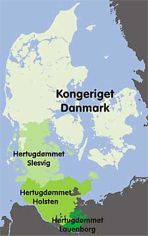
.jpg)
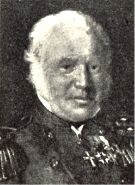
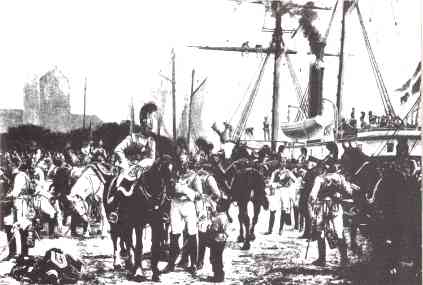
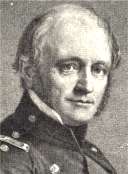
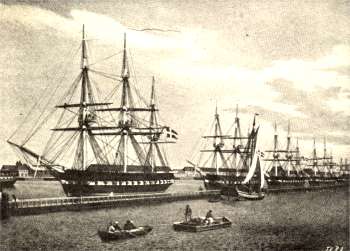
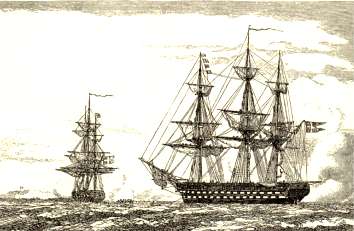
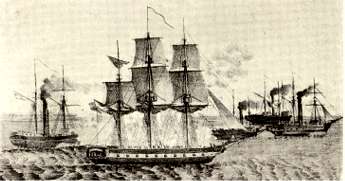
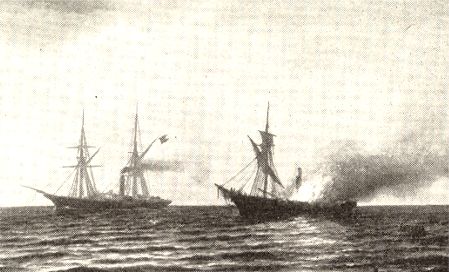
.jpg)